大模型的三大架構及T5體驗 原創
前言
本篇我們將對大模型的訓練階段進行初步了解,同時部署一個T5模型進行試用體驗。
大模型的三大架構
大模型(如大型語言模型)的架構通常有多種類型,以下是三種主要的架構:
Encoder-Decoder 架構
架構:由兩個主要部分組成:編碼器??(Encoder)???和解碼器??(Decoder)???,即??Transformer?? 架構。它先理解輸入的信息(Encoder部分),然后基于這個理解生成新的、相關的內容(Decoder部分)。
特點:
- 這種架構就像是翻譯家。他先聽你說一段話(比如英文),理解它,然后把它翻譯成另一種語言(比如中文)。
- 擅長處理需要理解輸入然后生成相關輸出的任務,比如翻譯或問答系統。
代表公司及產品:
- Google:Transformer、T5(Text-to-Text Transfer Transformer)
- Facebook:BART(Bidirectional and Auto-Regressive Transformers)
Encoder-Only 架構
架構:僅包含編碼器部分,即只是使用 ??Transformer??? 的 ??Encoder?? ,它專注于理解和分析輸入的信息,而不是創造新的內容。
特點:
- 這種架構就像是一個專業的書評家。他閱讀和理解一本書(輸入的信息),然后告訴你這本書是關于什么的,比如它的主題是愛情、冒險還是懸疑。
- 擅長理解和分類信息,比如判斷一段文本的情感傾向(積極還是消極)或者主題分類。
代表公司及產品:
- Google:BERT(Bidirectional Encoder Representations from Transformers)
- Facebook:RoBERTa、DistilBERT
Decoder-Only 架構
架構:僅包含解碼器部分,即只是使用 ??Transformer??? 的 ??Decoder?? ,它接收一些信息(開頭),然后生成接下來的內容(故事)。
特點:
- 這種架構就像一個講故事的人。你給他一個開頭,比如“有一次,一只小貓走失了”,然后他會繼續這個故事,講述下去,一直到故事結束。
- 擅長創造性的寫作,比如寫小說或自動生成文章。它更多關注于從已有的信息(開頭)擴展出新的內容。
代表公司及產品:
- OpenAI:GPT-3、GPT-4
三大架構演進圖
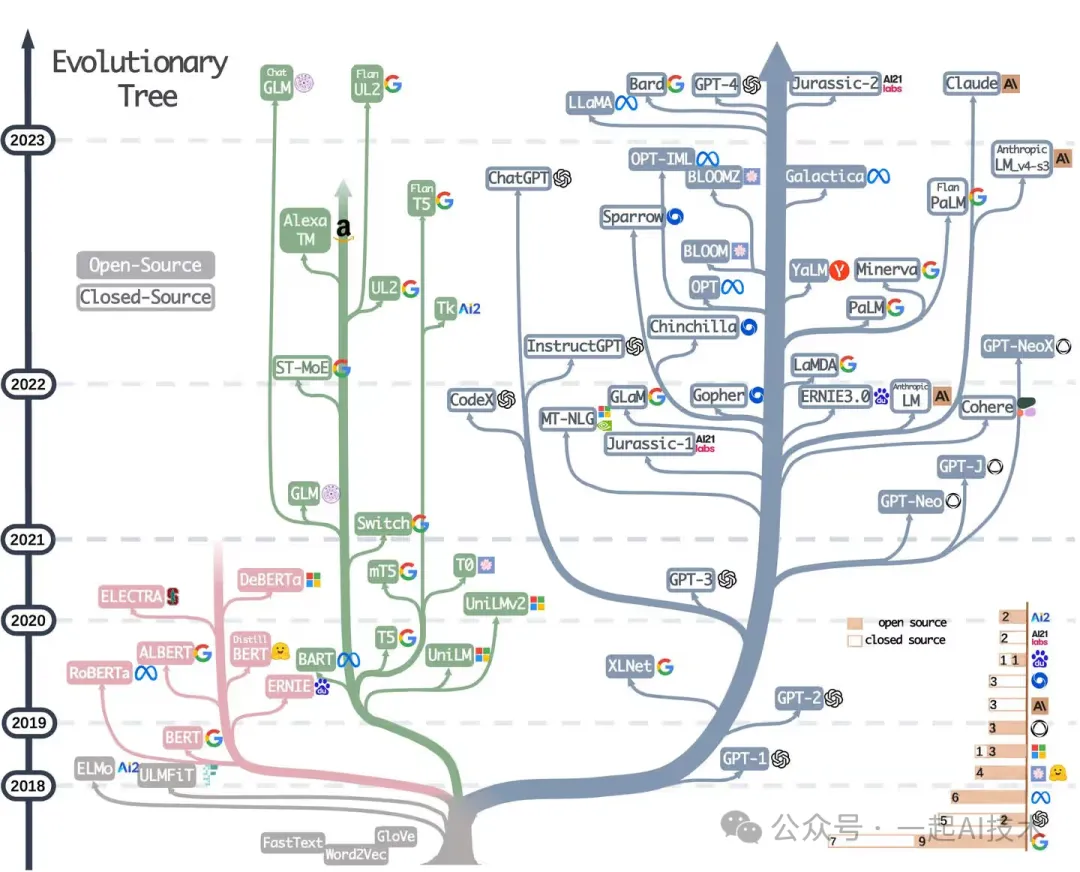
大模型T5的體驗
為了對大模型有個初步感受,本次我們拉取代碼在本地部署一個T5模型并體驗它。
環境搭建
體驗大模型的方法有兩種方案:??本地環境??? 和 ??遠程環境??。本章我們簡述遠程遠程環境的搭建方法。
遠程環境
第一步:訪問Modelscope平臺,注冊賬號。
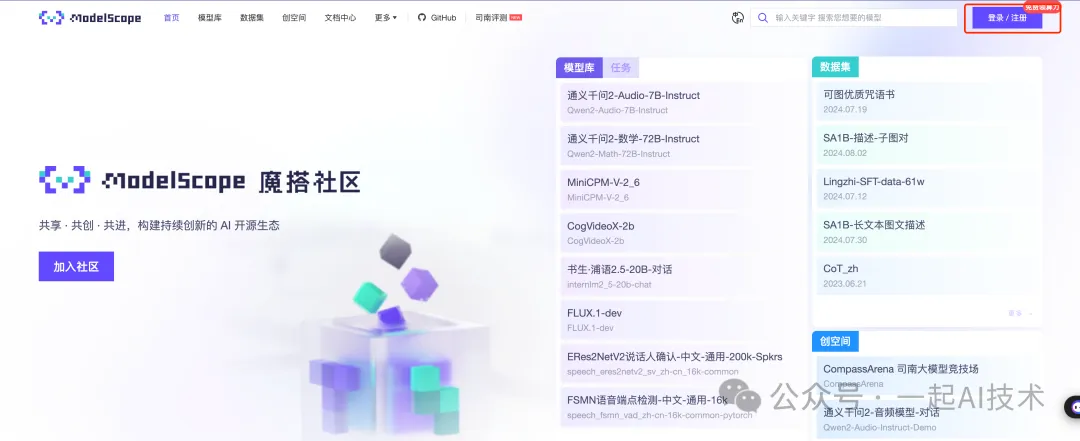
第二步:啟動魔搭平臺的PAI-DSW實例
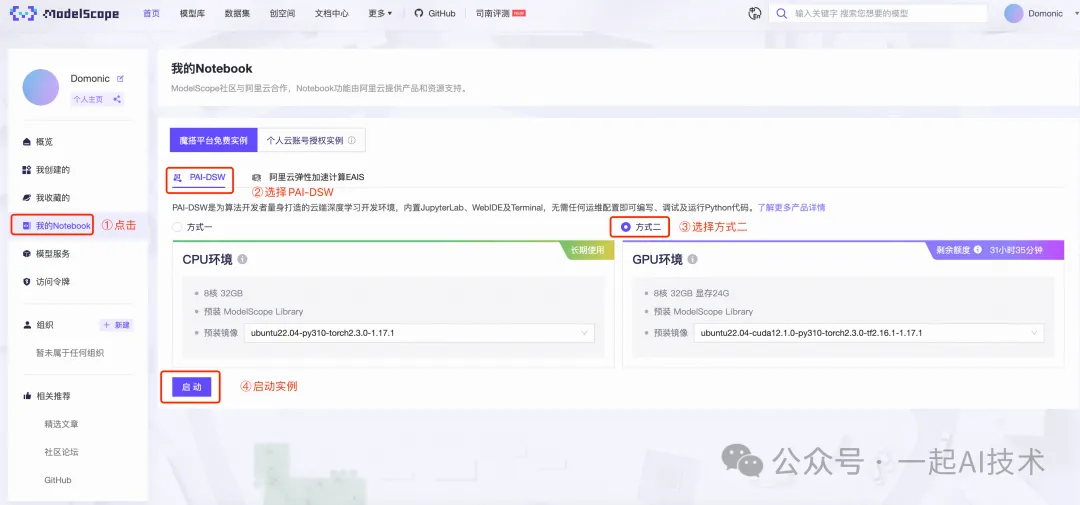
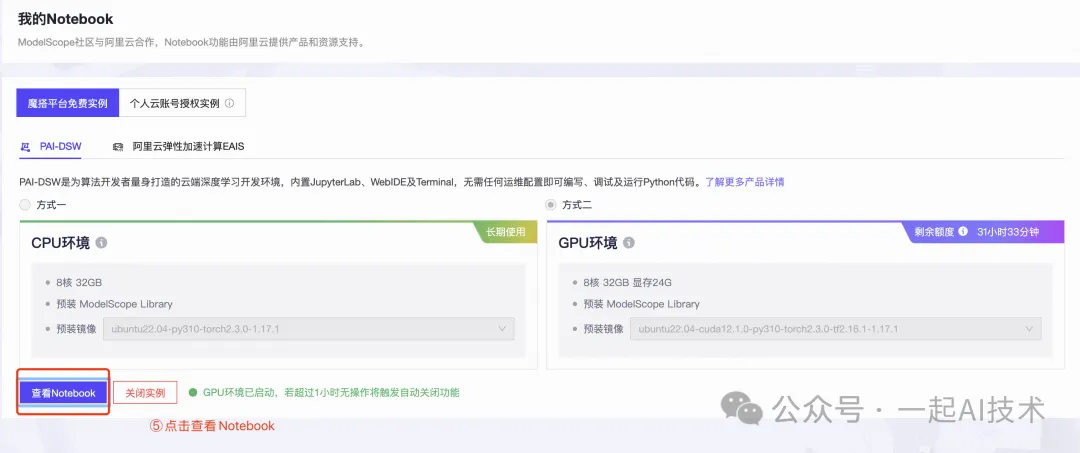
第三步:在新開的頁面中登錄阿里云賬號第四步:在PAI-DSW實例中啟動終端命令行
?
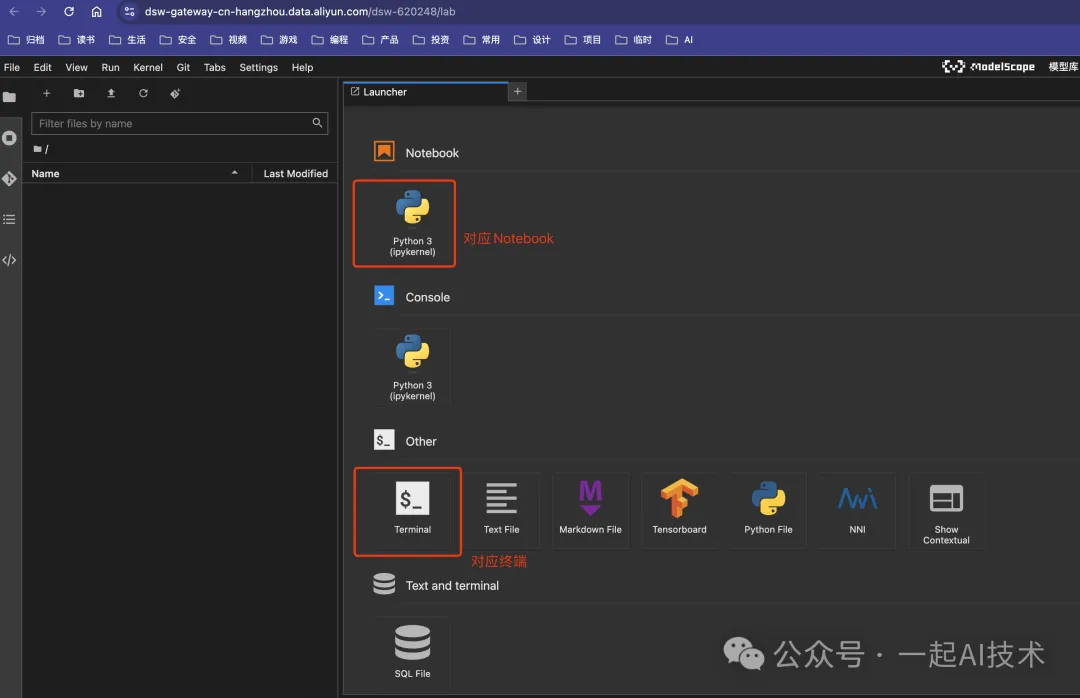
選擇模型
在魔搭平臺中搜索??ChatLM???模型,查看中文對話0.2B小模型,選擇 ??模型文件???,點擊 ??下載模型??。
代碼拉取
在終端中輸入以下命令,拉取模型代碼
git clone https://www.modelscope.cn/charent/ChatLM-mini-Chinese.git安裝依賴
pip install transformers模型使用
from transformers importAutoTokenizer,AutoModelForSeq2SeqLM
import torch
# 因為已經下載了模型,所以model_id改為本地路徑
model_id ='ChatLM-mini-Chinese'
# 判斷GPU是否可用
device = torch.device('cuda'if torch.cuda.is_available()else'cpu')
# 加載分詞器
tokenizer =AutoTokenizer.from_pretrained(model_id)
# 加載模型
model =AutoModelForSeq2SeqLM.from_pretrained(model_id, trust_remote_code=True).to(device)
txt ='如何評價Apple這家公司?'
# 對輸入內容編碼
encode_ids = tokenizer([txt])
input_ids, attention_mask = torch.LongTensor(encode_ids['input_ids']), torch.LongTensor(encode_ids['attention_mask'])
# 調用模型預測結果
outs = model.my_generate(
input_ids=input_ids.to(device),
attention_mask=attention_mask.to(device),
max_seq_len=256,
search_type='beam',
)
# 對輸出內容解碼
outs_txt = tokenizer.batch_decode(outs.cpu().numpy(), skip_special_tokens=True, clean_up_tokenization_spaces=True)
# 打印輸出
print(outs_txt[0])運行結果:
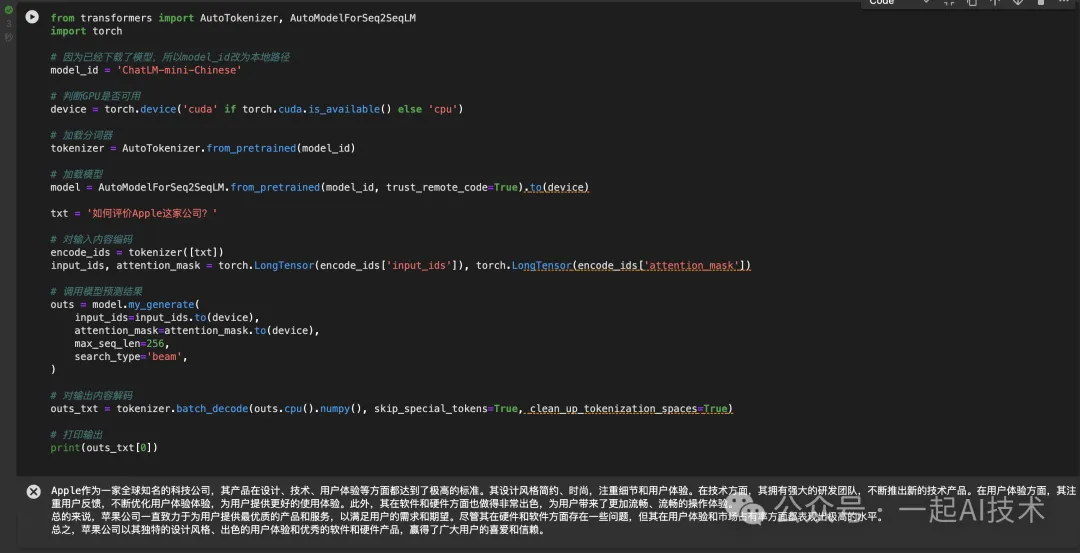
補充知識
tokenizer 分詞器
在Jupyter Notebook中查看??tokenizer??,可以看到分詞器中包含常見的Token。
PreTrainedTokenizerFast(name_or_path='ChatLM-mini-Chinese', vocab_size=29298, model_max_length=1000000000000000019884624838656, is_fast=True, padding_side='right', truncation_side='right', special_tokens={'eos_token':'[EOS]','unk_token':'[UNK]','pad_token':'[PAD]'}, clean_up_tokenization_spaces=True), added_tokens_decoder={
0:AddedToken("[PAD]", rstrip=False, lstrip=False, single_word=False, normalized=False, special=True),
1:AddedToken("[EOS]", rstrip=False, lstrip=False, single_word=False, normalized=False, special=True),
2:AddedToken("[SEP]", rstrip=False, lstrip=False, single_word=False, normalized=False, special=True),
3:AddedToken("[BOS]", rstrip=False, lstrip=False, single_word=False, normalized=False, special=True),
4:AddedToken("[CLS]", rstrip=False, lstrip=False, single_word=False, normalized=False, special=True),
5:AddedToken("[MASK]", rstrip=False, lstrip=False, single_word=False, normalized=False, special=True),
6:AddedToken("[UNK]", rstrip=False, lstrip=False, single_word=False, normalized=False, special=True),
}model 模型
在Jupyter Notebook中查看??model??,可以看到T5模型的結構。
TextToTextModel(
(shared):Embedding(29298,768)
(encoder): T5Stack(
(embed_tokens):Embedding(29298,768)
(block):ModuleList(
(0): T5Block(
(layer):ModuleList(
(0): T5LayerSelfAttention(
(SelfAttention): T5Attention(
(q):Linear(in_features=768, out_features=768, bias=False)
(k):Linear(in_features=768, out_features=768, bias=False)
(v):Linear(in_features=768, out_features=768, bias=False)
(o):Linear(in_features=768, out_features=768, bias=False)
(relative_attention_bias):Embedding(32,12)
)
(layer_norm):FusedRMSNorm(torch.Size([768]), eps=1e-06, elementwise_affine=True)
(dropout):Dropout(p=0.1, inplace=False)
)
(1): T5LayerFF(
(DenseReluDense): T5DenseActDense(
(wi):Linear(in_features=768, out_features=3072, bias=False)
(wo):Linear(in_features=3072, out_features=768, bias=False)
(dropout):Dropout(p=0.1, inplace=False)
(act):ReLU()
)
(layer_norm):FusedRMSNorm(torch.Size([768]), eps=1e-06, elementwise_affine=True)
(dropout):Dropout(p=0.1, inplace=False)
)
)
)
(1-9):9 x T5Block(
(layer):ModuleList(
(0): T5LayerSelfAttention(
(SelfAttention): T5Attention(
(q):Linear(in_features=768, out_features=768, bias=False)
(k):Linear(in_features=768, out_features=768, bias=False)
(v):Linear(in_features=768, out_features=768, bias=False)
(o):Linear(in_features=768, out_features=768, bias=False)
)
(layer_norm):FusedRMSNorm(torch.Size([768]), eps=1e-06, elementwise_affine=True)
(dropout):Dropout(p=0.1, inplace=False)
)
(1): T5LayerFF(
(DenseReluDense): T5DenseActDense(
(wi):Linear(in_features=768, out_features=3072, bias=False)
(wo):Linear(in_features=3072, out_features=768, bias=False)
(dropout):Dropout(p=0.1, inplace=False)
(act):ReLU()
)
(layer_norm):FusedRMSNorm(torch.Size([768]), eps=1e-06, elementwise_affine=True)
(dropout):Dropout(p=0.1, inplace=False)
)
)
)
)
(final_layer_norm):FusedRMSNorm(torch.Size([768]), eps=1e-06, elementwise_affine=True)
(dropout):Dropout(p=0.1, inplace=False)
)
(decoder): T5Stack(
(embed_tokens):Embedding(29298,768)
(block):ModuleList(
(0): T5Block(
(layer):ModuleList(
(0): T5LayerSelfAttention(
(SelfAttention): T5Attention(
(q):Linear(in_features=768, out_features=768, bias=False)
(k):Linear(in_features=768, out_features=768, bias=False)
(v):Linear(in_features=768, out_features=768, bias=False)
(o):Linear(in_features=768, out_features=768, bias=False)
(relative_attention_bias):Embedding(32,12)
)
(layer_norm):FusedRMSNorm(torch.Size([768]), eps=1e-06, elementwise_affine=True)
(dropout):Dropout(p=0.1, inplace=False)
)
(1): T5LayerCrossAttention(
(EncDecAttention): T5Attention(
(q):Linear(in_features=768, out_features=768, bias=False)
(k):Linear(in_features=768, out_features=768, bias=False)
(v):Linear(in_features=768, out_features=768, bias=False)
(o):Linear(in_features=768, out_features=768, bias=False)
)
(layer_norm):FusedRMSNorm(torch.Size([768]), eps=1e-06, elementwise_affine=True)
(dropout):Dropout(p=0.1, inplace=False)
)
(2): T5LayerFF(
(DenseReluDense): T5DenseActDense(
(wi):Linear(in_features=768, out_features=3072, bias=False)
(wo):Linear(in_features=3072, out_features=768, bias=False)
(dropout):Dropout(p=0.1, inplace=False)
(act):ReLU()
)
(layer_norm):FusedRMSNorm(torch.Size([768]), eps=1e-06, elementwise_affine=True)
(dropout):Dropout(p=0.1, inplace=False)
)
)
)
(1-9):9 x T5Block(
(layer):ModuleList(
(0): T5LayerSelfAttention(
(SelfAttention): T5Attention(
(q):Linear(in_features=768, out_features=768, bias=False)
(k):Linear(in_features=768, out_features=768, bias=False)
(v):Linear(in_features=768, out_features=768, bias=False)
(o):Linear(in_features=768, out_features=768, bias=False)
)
(layer_norm):FusedRMSNorm(torch.Size([768]), eps=1e-06, elementwise_affine=True)
(dropout):Dropout(p=0.1, inplace=False)
)
(1): T5LayerCrossAttention(
(EncDecAttention): T5Attention(
(q):Linear(in_features=768, out_features=768, bias=False)
(k):Linear(in_features=768, out_features=768, bias=False)
(v):Linear(in_features=768, out_features=768, bias=False)
(o):Linear(in_features=768, out_features=768, bias=False)
)
(layer_norm):FusedRMSNorm(torch.Size([768]), eps=1e-06, elementwise_affine=True)
(dropout):Dropout(p=0.1, inplace=False)
)
(2): T5LayerFF(
(DenseReluDense): T5DenseActDense(
(wi):Linear(in_features=768, out_features=3072, bias=False)
(wo):Linear(in_features=3072, out_features=768, bias=False)
(dropout):Dropout(p=0.1, inplace=False)
(act):ReLU()
)
(layer_norm):FusedRMSNorm(torch.Size([768]), eps=1e-06, elementwise_affine=True)
(dropout):Dropout(p=0.1, inplace=False)
)
)
)
)
(final_layer_norm):FusedRMSNorm(torch.Size([768]), eps=1e-06, elementwise_affine=True)
(dropout):Dropout(p=0.1, inplace=False)
)
(lm_head):Linear(in_features=768, out_features=29298, bias=False)
)- 查看該模型的結構,其結構是一個典型的?
?Transformer??模型結構。 - ?
?(encoder): T5Stack?? 是編碼器,其內部是由10個??T5Block??組成,??(decoder): T5Stack?? 是解碼器,其內部也是由10個??T5Block??組成。 - ?
? T5LayerSelfAttention?? 是自注意力處理模塊,??T5LayerCrossAttention?? 是融合注意力處理模塊,??T5LayerFF?? 是前饋模塊。 - ?
?(lm_head): Linear?? 是對應Transformer的輸出層。
內容小結
- 大模型有三大架構:Encoderdecoder、Encoder-Only、Decoder-Only。
- Encoderdecoder架構就像是翻譯家,代表模型是T5模型。
- Encoder-Only架構就像是書評家,代表模型是BERT模型。
- Decoder-Only架構就像是數學家,代表模型是GPT-4模型。
- 大模型訓練階段由三個階段組成:?
?預訓練(PT)?? 、??監督微調(SFT)?? 和??基于人類反饋的強化學習(RLHF)?? 。
本文轉載自公眾號一起AI技術 作者:Dongming

















